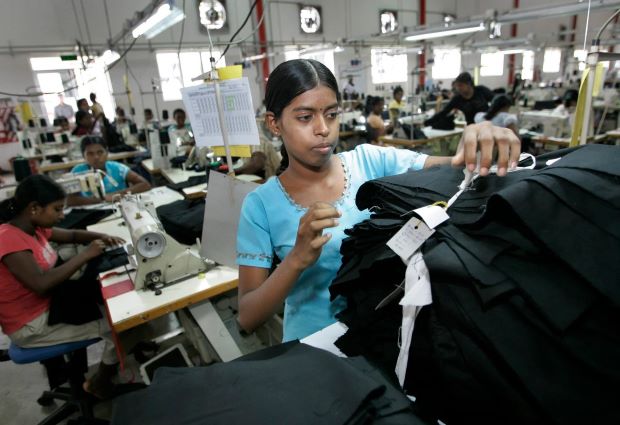Sri Lanka garment workers face job losses as factories lose to Bangladesh amid slowdown
By Dimuthu Attanayake
COLOMBO – Sri Lanka’s garment sector made up almost half its export revenue last year, after remaining resilient even through the pandemic and the country’s debilitating economic crisis.
But shocks in the international market have led to a plunge in demand, prompting factories to lay off hundreds of employees.
For one such worker, who wished to be known as Sunil, the loss of income came as a blow but he felt his youth was an advantage in the job hunt. For senior workers, especially older women, the likelihood of being employed again was low, he said.
Although the large manufacturer he worked at gave each worker a redundancy pay-out ranging from 100,000 to 150,000 Sri Lankan rupees (US$ 310-470), Sunil said it was not enough for any family to survive on. “Compensation cannot [match] the loss of permanent income,” he said.
Apparel is one of the biggest export earners in Sri Lanka, an industry that produces goods for major global retailers such as Marks & Spencer, Victoria’s Secret and Nike, among other brands. Last year, the sector accounted for some 46% of Sri Lankan export revenues, or US$ 5.93 billion.
But amid a challenging global economy, year-on-year export volumes shrank about 11% by March this year, industry statistics showed. Softening market conditions in the United States, European Union and Britain; fears of a global recession; and the Russia-Ukraine war accounted for a sharp contraction in demand, said Yohan Lawrence, head of the Joint Apparel Association Forum of Sri Lanka.
Loss of market share?
But the industry has bigger worries. Data suggests Sri Lanka is losing market share to neighbouring Bangladesh, Lawrence said.
From 2021 to 2022, Sri Lanka’s export revenue rose by 10%, from some US$ 5.07 billion to US$ 5.59 billion, while that of Bangladesh grew by 28%, from US$ 35 billion to US$ 45 billion.
The fact Bangladesh’s growth accounted for almost double of Sri Lanka’s entire market share was deeply worrying. “If that does not frighten [the country], I don’t know what does,” Lawrence said.
Trade agreements are at the core of this dynamic, since Bangladesh as a least developed country (LCD) holds more preferential trade terms, and could export apparel free of duty to the EU and the UK under the “Everything but Arms (EBA)” trade agreements.
Sri Lanka, however, trades under the Generalized System of Preferences (GSP), which comes with conditions based on the rules of origin.
This means to qualify for duty free entry into the EU or Britain, it has to be made from fabric from Sri Lanka or a country in the South Asian Association for Regional Cooperation (SAARC). But most of Sri Lankan apparel is made with fabric from places including mainland China, Taiwan and Thailand, and this raises duties by 10% when the EU and the UK import from Sri Lanka.
As a result, apparel made in Sri Lanka is less price-competitive than that of Bangladesh.
“[Sri Lanka] has to lobby for better trading terms,” Lawrence said.
Trouble at larger manufacturing facilities means the smaller factories which operated mainly as subcontractors during better times and took over some of the excess orders, would now get the short end of the stick.
“This year, we have had to move away from the subcontractors [as the orders declined], so some of those plants will actually shut down,” an executive from a leading apparel manufacturer said under condition of anonymity.
The garment industry in 2022 directly employed some 350,000 workers, who are now facing uncertainty amid the turmoil.
Manpower struggle
Factories operating at reduced capacity means the workers no longer receive overtime pay and other production related incentives, leaving them struggling for survival, said Chamila Thushari, Program Coordinator at Dabindu Collective, a Sri Lankan group advocating for rights of the apparel factory workers.
“Even with the incentives, they receive only 30,000 rupees per month. Now they buy food on credit and are struggling to pay rent and bills,” she said.
However, the brunt is borne by the daily-wage employees of the sector, dependent on a ‘manpower’ agency connecting them to some available work, ranging from cutting, washing and packing to cleaning, each day.
Chandra Devanarayana, the Founder of the Revolutionary Existence for Human Development organization, puts the estimate of manpower labourers at 19,000 to 20,000 each month. But now, only about 100 jobs are available per day, she said.
“Now I see them walking around for hours, pleading for work,” she said.
As the factories grind to a halt, the effects would also ripple to other services dependent on the apparel industry, from transport suppliers to security companies and caterers. It would also mean the micro economies operating near the factories, such as food vendors and small hostels run by the members of the local community, would contract, at least briefly.
Shama Gunasekara, 40, a worker from Hanwella town in Sri Lanka’s Western Province, earns around 40,000 rupees a month selling sweets near a large garment factory in the area.
A sole breadwinner, she said her family of four relied on her income.
“I am not sure what to do if the factory is not here. It is not profitable to keep a shop elsewhere. I have tried,” she said.
Lawrence said he was confident the industry could ride out the crisis. But the situation would not reverse for “at least another two quarters”, he said.
-Dimuthu Attanayake is an independent journalist and a researcher from Sri Lanka, covering business, tech, social issues, and environment and this article was originally featured on -scmp.com



Comments are closed, but trackbacks and pingbacks are open.